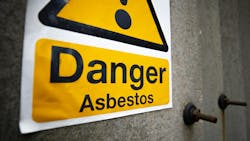How to Deal with Asbestos and Other Health Hazards After a Fire
A fire can be the biggest catastrophe that building owners and facility managers face, and the danger doesn’t end when the flames are extinguished. The aftermath of a fire often exposes many harsh chemicals and materials—like asbestos —that are a threat to staff, residents and emergency workers.
If you are a building owner or facility manager, it’s crucial to know the best practices for dealing with health hazards following a fire. Here are six strategies to keep top of mind.
1. Assess the Property Thoroughly
Once the fire department has put out the flames and checked the integrity of the structure, an essential next step is assessing the property thoroughly for the presence of any dangerous substances. These substances can lurk in unexpected places, especially if a property is several decades old. Plastics, paints, insulation, metal and other building materials can all release hazardous particles into the air when they burn or are exposed to extreme heat.
Building owners and facility managers should work alongside health, environmental, and cleaning and restoration experts to identify these risks, and then develop a comprehensive plan for mitigating them.
2. Wear the Proper Personal Protective Equipment
Many people think that firefighters’ personal protective equipment (abbreviated as PPE) is used exclusively to shield them from heat, flames and smoke. In fact, it also provides vital protection from health hazards that are present after the fire. Building owners and facility managers should take the same precautions if they are on-site. Proper clothing and gloves, along with respirators, goggles and other equipment, are necessary to prevent exposure to heavy metals and toxic gasses. You don’t want to come into contact with lead, mercury or hydrogen cyanide, all of which can be present in the aftermath of a fire. And it’s not enough to simply wear this equipment—you should be properly trained on its usage, care and disposal, too.
3. Leverage Wet Methods
Even when the fire is extinguished, water can still be a crucial tool for staying safe. Cleaning and restoration professionals will often use “wet methods” to make properties safer. This entails spraying or misting surfaces like walls and floors to prevent dust, debris, and fibers from becoming airborne during the clean-up process. This technique goes a long way toward staying safe.
4. Be Wary of Asbestos
Veteran building owners and facility managers know full well about the presence—and danger—of asbestos. The fiber was previously a go-to substance in construction, used for everything from building to insulation. However, it was later determined to be a public health hazard, causing respiratory issues and even cancer. Fires can disturb asbestos, transforming its fibers into an airborne danger. Owners and managers should take care to know if asbestos is present in their properties before any kind of fire takes place. And if one does, owners and managers should work with qualified cleaning and restoration professionals to remove the affected material. This can entail sealing off contaminated areas, disposal practices that are legally required and carefully controlling air flow.
5. Dispose of Waste Properly
Given the dangerous nature of the substances discussed so far, it’s not adequate to simply put fire debris in the garbage for regular pickup. Like asbestos, many hazardous waste materials are carefully regulated, and for good reason. Work with cleaning and restoration professionals, who will cart materials to licensed disposal locations and maintain a paper record of the process.
6. Monitor the Air Quality Carefully
It’s essential for building owners and managers to meticulously monitor the air quality in and around their property after a fire. By staying vigilant, you can identify—and mitigate—the presence of any hazards before they cause harm. Deploy devices like smoke and particulate monitors, gas detectors, and thermal imaging cameras to remain proactive. And if the monitors turn something up, take action swiftly by contacting and working alongside the relevant cleaning and restoration professionals.
The aftermath of a fire can be just as dangerous as the blaze itself. If you’re a building owner or facility manager, it’s crucial to know this—and to have a plan for keeping staff and residents safe in such a scenario. By using the above techniques and tools, you can ensure everyone impacted by the disaster remains as safe as possible.
About the Author
Ron Fanish
Ron Fanish is co-owner of Rainbow Restoration of Westchester, a full-service, one-stop-shop for restoration, cleaning, and reconstruction based in Westchester County, New York. For more information, visit www.RBWWestchester.com.
